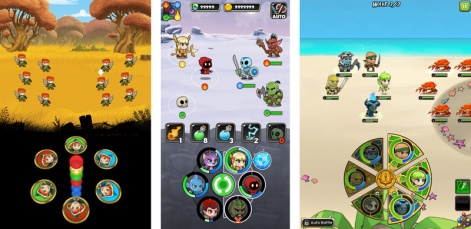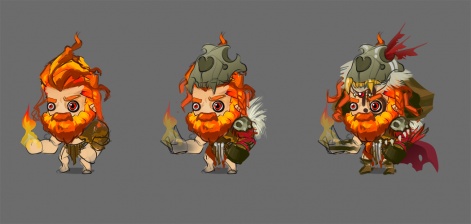The world doesn’t need another mobile RPG, but that’s exactly what London startup The Secret Police has given it.
Formed in 2015 by industry veterans Ric Moore (Bossa) and Harry Holmwood (Marvelous), their inspiration was threefold.
- RPGs are niche mobile games in terms of downloads but the most lucrative genre in terms of per player monetisation
- RPGs are massively popular in Asia but Asian RPGs - best known by the moniker Japanese or JRPGs - are often too complex for a mass market western audience
- RPGs follow a set of key metagame features but gameplay was ripe for reinvention
The result is Dragon’s Watch, an Asian-inspired mobile RPG designed for a western audience and featuring significant gameplay innovation.
Bottom up
“We knew it was a risky time to start a new studio, but we kept coming back to the same idea, which was to make an RPG for a western audience that fixes all the obvious problems they have,” explains Moore of the vision that’s sustained The Secret Police and Dragon’s Watch.
To compound the risk, Moore and Holmwood decided to self-publish.
“There was lots of interest from publishers but the deals tended to be ‘take no risk, get all the upside’,” says Moore.
Development took significantly longer than expected, but the game is better for it.Ric Moore
Thankfully, the previous experience of the company’s co-founders meant The Secret Police could self-fund, with investment raised from industry figures including éminence grise Ian Livingstone.
The inside track was also useful when it came to hiring for the now 10-strong team.
“All but one of the team were either recruited via people we know or were someone I’d worked with before,” Moore says. “It can be hard recruiting when a company has no track record.”
Finding the way
As always seems to be the case, development took longer - “significantly longer” says Moore - than expected, “but the game is better for it”.
Particular attention in the early days was spent on Dragon’s Watch’s unique selling point, its revolving squad selector.
Simply put, this is a 6-spot disc the player rotates at the start of each turn to select the three heroes they are going to use. Not only does this enable you to move heroes with low health out of harm’s way, but you can move heroes with special attacks or class advantages to the fore.
It started out as something rather more complex, however.

“Originally the revolver was in the middle and had lanes of baddies feeding into each segment, kind of like a tower defence game,” Moore reveals.
“It didn’t work as well. There was too much going on and the pacing was peculiar. It also crammed a lot onto one screen. When we switched to what the game is now, it felt a lot better.”
The game’s art style has evolved over time too.
It would be wrong to see Dragon’s Watch as a watered down version of Asian mobile RPGs.
“In the beginning, the characters were a lot simpler, but over time we adopted a more painterly rendering, like Blizzard’s Hearthstone,” says lead artist Gina Nelson.
“We have, however, kept to the same proportions and overall look that’s popular in Asia. I guess you could call our style a unique western kind of Chibi.”
Pushing the limits
Yet it would be wrong to see Dragon’s Watch as a watered down version of Asian mobile RPGs.
Certainly, the user experience is more welcoming and intuitive for its target audience, but aside from the gameplay revolver, some of the game’s less obvious but novel features have arisen from an interplay between source material and local tastes.
One seemingly small element - a direct result of commuting with access to London’s patchy wifi underground network - is the ability to play offline.
“This is something no other RPG does, and there are mountains of good technical reasons why,” explains lead designer/coder Charles Gbadamosi.
“But it was personal to us; something we felt we needed to do despite the immense challenge, so we did it.”
The team’s passion to do something that stands out is also reflected in the game’s scale, especially the over 800 playable characters.
“We’re of the opinion variety is king, so we hope there’s something here for everyone,” Gbadamosi enthuses.
“And it goes beyond collection. We believe that a strong competitive metagame can only develop when you give players strategic options to explore. Mobile games often receive criticism for lacking depth and we feel that Dragon’s Watch is a rejection of that statement: it has real depth.”
Dragon’s Watch is a rejection of the statement that mobile games lack depth.Charles Gbadamosi
In the long term, this means a focus on the game’s PVP mode, something Moore currently labels “PVP Lite”.
“We have big plans to improve it but we haven’t had the time yet,” he says.
Also in progress is a rune system which will unlock a new layer of character - and hence squad - customisation.
“We see it as a way to plug weaknesses or accentuate strengths on characters,” Gbadamosi says. “There’s a combinatorial element - the right combinations can be game changing - and we expect players to use wildly different recipes for success.”
Building up
Returning to the original inspiration, perhaps the most surprising thing about Dragon’s Watch is its low key monetisation.
“Our aim was to make a game that’s compelling, then hope people will want to spend,” Moore says.
Currently, such behaviour is driven by the desire to get more characters. As well as the underlying collection mechanic, players need a large set of levelled up heroes to maximise the time-based Watch, or idle, missions.

Moore is also keen to highlight the PVP mode doesn’t reward large levels of spending either.
“PVP has all the heroes capped at the same level, making it about strategy rather than the strongest team. We didn’t want it to be pay-to-win,” he says.
Dragon’s Watch doesn’t even include video ads, although these may be added in future to enable players to get more energy.
So, for now, following its prolonged gestation, the developers are just happy and relieved to have their game released and are basking in the reaction.
“The reception has been fantastic. Honestly we weren’t expecting this much love,” says Gbadamosi.
“It’s a beautiful thing to see people enjoy something you’ve worked so hard on.”
You can download Dragon’s Watch from the Apple App Store here and Google Play store here.




















